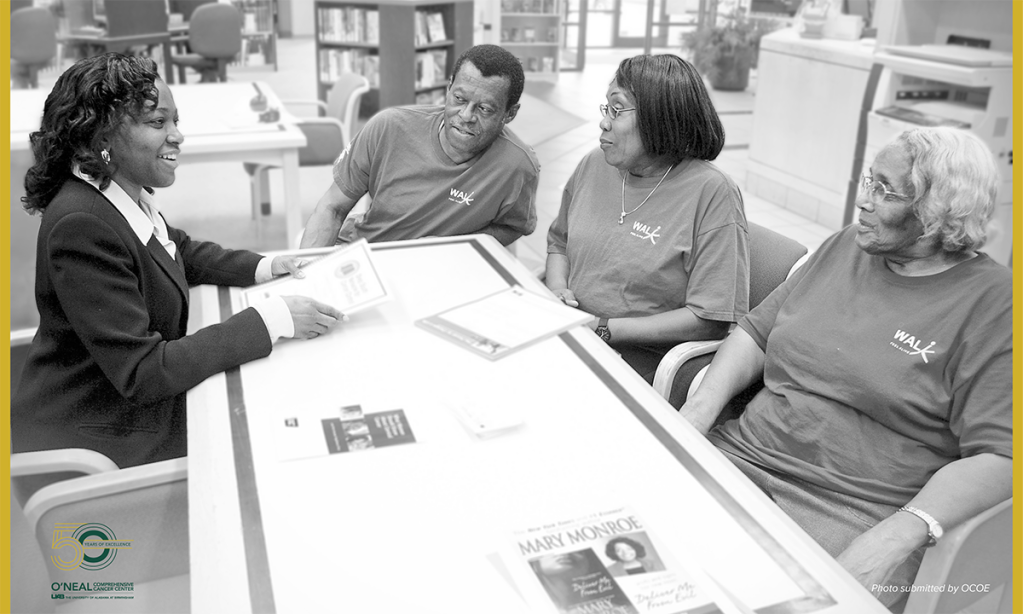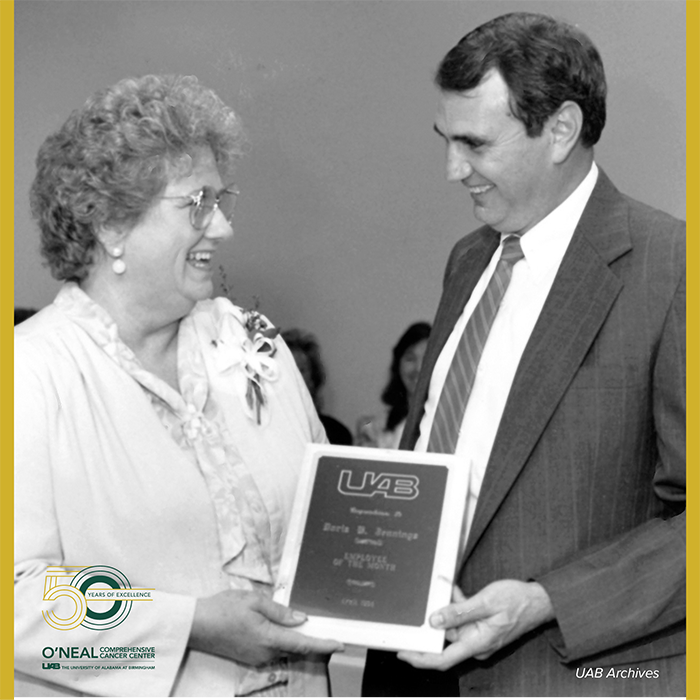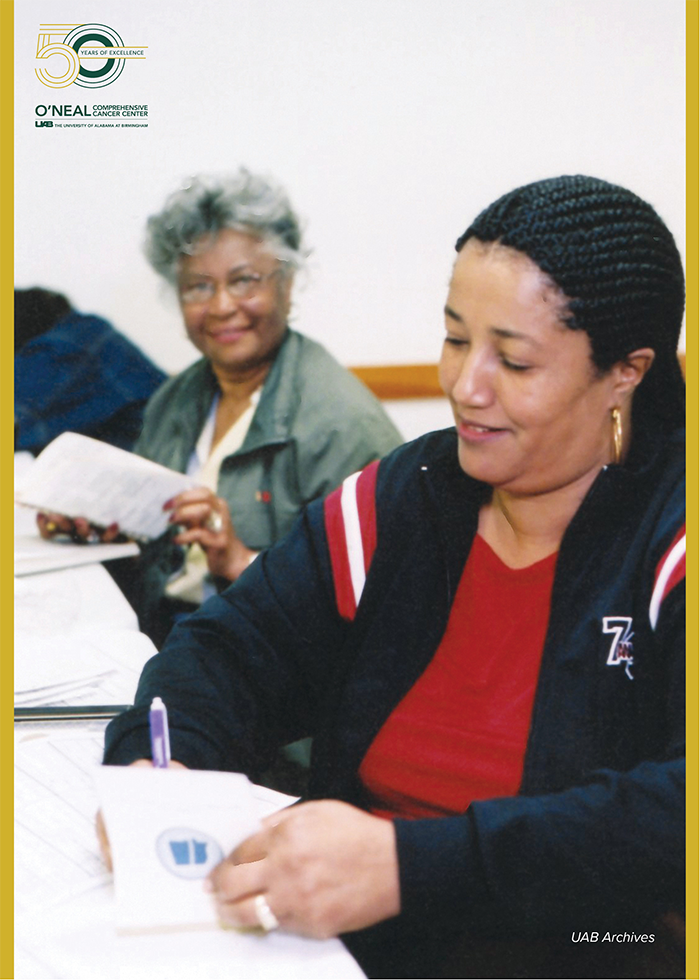Cancer Disparities Through the Decades
Story by Claudia M. Hardy and Joseph D. Bryant | Photos courtesy of the UAB Archives

For decades, the UAB O’Neal Comprehensive Cancer Center has worked to eliminate differences in cancer prevention, care and survivorship based on race, place and socioeconomic status.
Over the past 50 years, the O’Neal Cancer Center has brought together a robust, passionate team of clinicians and researchers to accomplish a shared mission: to eliminate cancer disparities in the state, the region and beyond. The Cancer Center’s success in addressing these disparities is based on a multilevel approach to outreach and education among communities with poor cancer outcomes, including medically underserved communities, rural communities and communities of racial and ethnic minorities.
Early years
While not initially identified as a cancer disparity, death rates among Black people in the United States were rising at 2.5 times the rate of white people between the mid-1970s and 1980s. However, by the late 1980s, the National Cancer Institute required its NCI-Designated Comprehensive Cancer Centers to formally include cancer prevention and control programs to address disparities within the structure of those centers.
One of the initial attempts by the O’Neal Cancer Center to address the burden of cancer for different populations was the implementation of the Cancer Information Service in 1980. The CIS was a 24-hour phone counseling and information resource, sponsored by the NCI, aimed at providing community members with accurate and up-to-date information about cancer care. The CIS program was led by CIS Partnership Manager Earl Sanders and CIS Program Manager Susan Baum. Sanders would later become the first program manager for the Cancer Center’s Office of Community Outreach.
Cancer health disparities are negative differences between certain population groups in cancer measures.
These measures can include new cases, all existing cases, cancer-related health complications, deaths, survivorship, quality of life after cancer treatment, screening rates and stage at diagnosis.
Additionally, Seng-jaw Soong, Ph.D., former director of the Cancer Center’s Biostatistics Unit, as well as C. Michael Brooks, Ed.D., and William Bailey, M.D., of the UAB Lung Health Center, started providing outreach, education and smoking cessation programs for the local community in the late 1980s.
John Durant, M.D., the Cancer Center’s first director, also recognized the opportunity to prepare aspiring clinicians to meet the challenges of differentially applied evidence-based interventions by exposing them to cancer research.
Durant enlisted the help of Brooks and Sam Brown, Ed.D., who, respectively, served as the associate director and director of the Office of Educational Development in the UAB Heersink School of Medicine. Brooks also helped lead a cancer education grant that provided training for medical and dental students.
“These cancer education grants were the beginning of cancer outreach and education for the Cancer Center,” Brooks said.

Disparities in the 1990s
By 1983, Albert LoBuglio, M.D., had been recruited to the Cancer Center to serve as its second-ever director, and by 1992, LoBuglio had recruited gynecologic oncologist Edward Partridge, M.D., from private practice to join the Cancer Center as well. Partridge soon began working with Brooks to canvass every funded grant at UAB that focused on cancer.
The two men then galvanized investigators throughout the university to form a new Cancer Prevention and Control Committee that formalized cancer prevention and control at the Cancer Center and its mission to reduce or eliminate cancer disparities. It became evident to the committee that diagnostic procedures and clinical treatments for cancer varied largely based on race, socioeconomic status and geographic location.
“In the 1970s, we discovered things like mammography and colonoscopy, and we developed some reasonably effective chemotherapy so we could impact outcomes,” Partridge said. “But beginning in the 1980s, those discoveries were delivered differentially.”
In 1994, the committee hosted its first retreat at the Carraway Davie House and Conference Center in Birmingham. By then, Partridge, Soong, Brooks and Bailey had begun to build a team to help them address the vast differences that had become evident between the experiences of Black people and those of white people with regard to cancer screening, incidence and mortality. Instrumental to this work was Linda Goodson from the UAB School of Nursing and Suzanne Churchill Reaves, who worked in the Office of Educational Development.
The retreat helped identify several goals for the committee, including the allocation of funds to hire two full-time staff members dedicated to community outreach: Reaves, who would serve as the first community outreach coordinator, and Lydia Cheney, who would serve as the cancer education manager. These hires eventually led to the development of the Office of Community Outreach at the Cancer Center.
Reaves and Cheney worked together to build outreach and education programs for the kinds of communities most affected by cancer disparities.
“We raised awareness among the underserved population that there was hope and that early detection was critical,” Cheney said. “With many people, there was a feeling of shame. They didn’t want people to know they had a cancer diagnosis.”
Decades later, Cheney still has a ballpoint pen upon which six cancer messages promoted by the outreach group are printed. She says that one message, in particular – “Cancer: There is hope” – remains unforgettable for her.
“What we started was powerful, and it was making a difference,” she said. “We were doing some serious work right here in the Deep South.”
In 1992, the group wrote and received its first grant with UAB breast cancer specialist John Carpenter, M.D., as principal investigator and Partridge as co-principal investigator. The grant, called the Black Belt Community Linkage, allowed the Cancer Center to work with primary care doctors and local health departments in the cities of Tuscaloosa, Selma and Montgomery, Alabama, to promote cancer screening and treatment in high-risk populations.
Partnerships: Key to addressing cancer disparities
Mona Fouad, M.D., MPH, is the senior associate dean for Diversity & Inclusion at the UAB Heersink School of Medicine, the director of the UAB Division of Preventive Medicine, the founding director of the Minority Health & Health Disparities Research Center at UAB and a senior scientist at the O’Neal Cancer Center.
Before there were grants or formalized agreements, Fouad remembers burgeoning community relationships and a shared vision to tackle major health inequities in some of the most challenged communities in the Deep South. For more than 15 years, Fouad and Partridge were co-leaders of cancer control programs designed to address the dramatic disparity in cancer mortality rates.
“I found out that, if you targeted and worked with people one on one and understood the challenges, then you could make a difference,” Fouad said.
The Cancer Center was instrumental in developing partnerships and coalitions with individuals, organizations, staff and investigators across the state to address disparities. These partnerships illustrated broad collaboration and a focus on a single goal, which legitimized efforts that eventually earned grant support from the National Institutes of Health and the NCI.
These key partnerships included:
- Serving as a founding member of the Alabama Comprehensive Cancer Coalition
- Developing and providing administrative leadership for the Alabama Partnership for Cancer Control in the Underserved
- Hosting the annual Urban Cancer Conference in partnership with the American Cancer Society for several years
- Collaborating with national and state agencies, such as the American Cancer Society, the Alabama Department of Public Health, Susan G. Komen, the Alabama Cooperative Extension Service and local organizations, including House of Hope in Mobile, Alabama, and community churches
In addition to building mutually beneficial partnerships, the Cancer Center was also focused on understanding and improving minority participation in clinical trials.
In the mid-1990s, the Cancer Center hosted a regional conference with Tuskegee University where individuals from all over the state convened in Tuskegee, Alabama, at the historic university’s Kellogg Conference Center to raise awareness about the need to increase minority participation in clinical trials.
The regional conference between the Cancer Center and Tuskegee University, which was referred to as the Sowing the Seeds Conference: Minorities in Clinical Trials, sought to share innovative approaches that would assist cancer researchers in recruiting and retaining minorities into clinical research trials.
The Community Health Advisor model
Another outcome of the Cancer Prevention and Control Committee’s 1994 retreat was the push to create a program that would mobilize individuals from minority communities to build trust with and educate those within their own communities with the goal of impacting cancer screening rates. From there, the Community Health Advisor, or CHA, model was born.
Leaders in the earliest days of the Office of Community Outreach at the Cancer Center realized that a community-based approach was the best way to address the challenges inherent to racial inequities and cancer-related health disparities. The CHA model became the vehicle for tackling those challenges.
The idea originated from an earlier collaboration between UAB and Auburn University that paired health educators with county extension agents. Partridge, who was the director of the Cancer Center at the time, hoped to take this model and use it to promote cancer education.
An early version of the CHA model began in Bessemer, Alabama, with residents of the Bessemer Housing Authority. Both the effort and the network expanded into Alabama’s Black Belt region as the Office of Community Outreach recruited more community advocates.
“We just started county by county,” Reaves said. “We had a lot of good partners in that area.”
Among the earliest CHA initiatives was the West Alabama Breast and Cervical Cancer Outreach Program in late 1998. This initiative, funded by the Alabama Department of Public Health, brought about change for the Office of Community Outreach. With a new program manager, the program pilot tested the CHA model in three rural counties across Alabama’s Black Belt region.
Disparities in the 2000s: The Deep South Network era
Due to the success of the projects piloted by the CHA model, the Office of Community Outreach received an NCI Special Populations Network Grant in 2000 that would establish the Deep South Network for Cancer Control. The Deep South Network would become the infrastructure that grew the Office of Community Outreach from a staff of fewer than three to a staff of more than 25.
As a result of the Deep South Network, the office trained 884 CHAs as Research Partners, or CHARPs, and developed a Minority Investigator Training Program that led to an increase in minority participation in clinical trials. These efforts covered 12 counties in Alabama and 10 counties in Mississippi.
In the early 2000s, the Office of Community Outreach noted an increase in the Hispanic population across the Deep South and, therefore, a need to address cancer disparities in those communities. Isabel Scarinci, Ph.D., MPH, joined the Cancer Center in 2002 and soon began learning more about the CHA model to replicate it for Hispanic and Latino, Latina and Latinx communities.

“I was so impressed with the work done with CHA volunteers that I took that model to the growing Latino population in Alabama and started an outreach program for Latino immigrants that promoted breast and cervical cancer screenings, totally relying on volunteers,” Scarinci said.
In 2005, the Cancer Center received funding for an additional five years to continue the work started as part of the NCI’s Community Network Program mechanism, which further addressed cancer disparities by focusing on community networks and evidence-based interventions.
Through a network of hundreds of CHARPs and hundreds of community partners and steering committees, the Office of Community Outreach continued to fight cancer disparities by promoting cancer screening and healthy lifestyle behaviors and advocating for increased funding for cancer prevention and care.
The Deep South Network also contributed to the elimination of the disparity in mammography screening rates between Black and white women in the Medicare population from 1999 to 2012.
In 2010, the Deep South Network was renewed for the third time under the NCI’s Community Network Programs Center mechanism. After 10 years under the previous two five-year funding mechanisms, this new CNPC mechanism allowed the Cancer Center to conduct a randomized, community-based research intervention for women in Alabama and Mississippi.
Monica Baskin, Ph.D., then an associate professor at UAB and a mentee of Partridge, led the project that would deliver the intervention. The project, called Journey to Better Health, implemented a weight loss program for African American women living in eight rural Alabama and Mississippi counties.
Since then, the CHA model and its use in addressing cancer disparities have become known across the United States and the world. The model was replicated in the Mid-South and South Atlantic divisions of the American Cancer Society, as well as in Zambia through a collaborative project with O’Neal Cancer Center Senior Scientist Michael Saag, M.D., and the University of North Carolina at Chapel Hill.
Disparities since 2018: The O’Neal story
In 2017, the National Cancer Institute further defined the role of community outreach and engagement for its designated centers by including new core grant requirements that formalized efforts to address cancer disparities within an institution. While the O’Neal Cancer Center had already spent decades working to fight disparities, this change from the NCI prompted the Cancer Center to fully integrate the Office of Community Outreach within its institutional structure and across the translational continuum, from scientific research to clinical care, for the first time.
In 2018, Baskin became the inaugural associate director for Community Outreach & Engagement at the O’Neal Cancer Center and the head of the newly renamed Office of Community Outreach & Engagement. Baskin worked to realign the office with the new NCI requirements. To this end, the office developed programs that would serve more than the 12 counties it had been limited to in the past and would, instead, encompass the entirety of the Cancer Center’s catchment area, which includes the entire state of Alabama.
Since then, the office has established a Community Advisory Board; continued to engage its staff, volunteers and other stakeholders at various community events, such as its annual Community Dissemination Institute; built a community access program to connect individuals to cancer screening services in their local communities; further expanded the use of the CHA model and increased the scope of its efforts to include a total of seven impact cancers – brain cancer, breast cancer, cervical cancer, colorectal cancer, lung cancer, prostate cancer and multiple myeloma – whose disparities and rates of mortality are among the worst in the state.
“There has been much progress in addressing cancer disparities over the past five decades, but I see the path to fully eliminating this difference in mortality and outcomes within my lifetime,” Baskin said.
The O’Neal Cancer Center remains a national and global leader in addressing cancer disparities, in part due to the success of its community outreach and engagement efforts. In its 50 years, the Cancer Center has worked to reduce these disparities by engaging with its community stakeholders and partners, delivering effective methods of prevention and ensuring access to high-quality care for all of its communities, particularly those who have historically been the most severely impacted by cancer.
To date, the O’Neal Comprehensive Cancer Center and the Office of Community Outreach & Engagement have made the following strides in addressing cancer disparities:
- Over the past four years, outreach and education activities at the O’Neal Cancer Center have reached more than 200,000 people across 55 counties in Alabama.
- The Office of Community Outreach & Engagement has navigated 849 people to screening for breast, cervical, lung and prostate cancers.
- Since 2000, the Office of Community Outreach & Engagement has trained 2,159 people to serve as Community Health Advisors.
- Currently, the Office of Community Outreach & Engagement has 437 active Community Health Advisors. Of these, 26 have served as CHAs at the O’Neal Cancer Center for 20 or more years.
In 2020, the Office of Community Outreach & Engagement celebrated its 25th anniversary. While considering the impact of the office since it officially began in 1995, O’Neal Cancer Center Director Barry Sleckman, M.D., Ph.D., noted why its efforts are vital to fighting disparities.
“Since I’ve been here, I’ve learned about the incredible work the office has done,” Sleckman said. “There are still quite a lot of disparities and cancer burdens in the state, but I think, with our community outreach and engagement programs and our team at the O’Neal Comprehensive Cancer Center, we can make an impact on those disparities and burdens.”
Editors Notes:
- Claudia M. Hardy, MPA, is a guest writer for this issue of the O’Neal Comprehensive Cancer Center magazine. Hardy has worked as a manager and a director in the Office of Community Outreach & Engagement for more than 23 years and has led many of the O’Neal Cancer Center’s efforts to address cancer health disparities.
- At time of web publication, Isabel Scarinci, Ph.D., MPH, now leads the Office of Community Outreach & Engagement as interim associate director for Community Outreach & Engagement.




